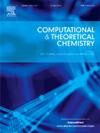Investigations on acid/base-catalyzed hydrolysis mechanisms of mono(2-hydroxyethyl) terephthalate using quantum chemistry methods
IF 3
3区 化学
Q3 CHEMISTRY, PHYSICAL
引用次数: 0
Abstract
The mechanisms and kinetics of acid/base-catalyzed hydrolysis of PET model compound, mono(2-hydroxyethyl) terephthalate (MHET), were evaluated by quantum chemical methods. For acid-catalyzed hydrolysis, the most feasible degradation pathways involved the protonation of the most negative potential oxygen atom Ocarbonyl. The ester bond was subsequently cleaved to form terephthalic acid (TPA) and a cationic intermediate, with the energy barrier of 94.0 kJ/mol. For base-catalyzed hydrolysis, [OH]− tends to attack the Ccarbonyl atom of MHET to form an anionic intermediate, requiring overcoming a barrier height of 158.3 kJ/mol due to the electron outflow from the lone pair of [OH]− to the empty p orbital of the Ocarbonyl and Oester atoms. For solvent effect, a tend was observed that related the reaction energy barrier positive correlation to the polarity of the solvent. Cations are beneficial for stabilizing the transition state, whereas counteranions did not significantly change the reaction energetics.

用量子化学方法研究酸/碱催化对苯二甲酸一(2-羟乙基)酯水解机理
采用量子化学方法评价了PET模型化合物对苯二甲酸一(2-羟乙基)酯(MHET)酸/碱催化水解的机理和动力学。对于酸催化的水解,最可行的降解途径涉及到最负电位的氧原子羰基的质子化。酯键裂解生成对苯二甲酸(TPA)和阳离子中间体,能垒为94.0 kJ/mol。对于碱基催化的水解,[OH]−倾向于攻击羰基原子形成阴离子中间体,由于电子从[OH]−的孤对流出到羰基和酯原子的空p轨道,需要克服158.3 kJ/mol的势垒高度。对于溶剂效应,反应能势垒与溶剂极性呈正相关。阳离子有利于稳定过渡态,而反阴离子对反应能量没有显著影响。
本文章由计算机程序翻译,如有差异,请以英文原文为准。
求助全文
约1分钟内获得全文
求助全文
来源期刊

Computational and Theoretical Chemistry
CHEMISTRY, PHYSICAL-
CiteScore
4.20
自引率
10.70%
发文量
331
审稿时长
31 days
期刊介绍:
Computational and Theoretical Chemistry publishes high quality, original reports of significance in computational and theoretical chemistry including those that deal with problems of structure, properties, energetics, weak interactions, reaction mechanisms, catalysis, and reaction rates involving atoms, molecules, clusters, surfaces, and bulk matter.
 求助内容:
求助内容: 应助结果提醒方式:
应助结果提醒方式:


